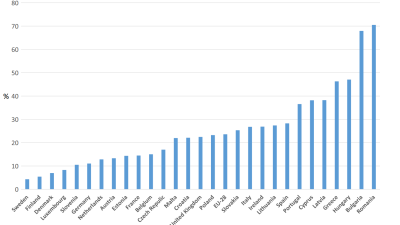Research which the author undertook between 2011 and 20131 indicates that Government spending cuts have made it harder for disabled workers to remain in employment.
Disabled people not in paid employment have been amongst the hardest hit by Coalition government policies. Disability benefits have been cut (Cross, 2013); claimants have been "migrated" from disability benefits onto lower paying Job Seekers Allowance (Patrick, 2012); and record numbers have had their benefits "sanctioned" (Webster, 2014), with sanctions contributing to widespread destitution (e.g. Scottish Parliament’s Welfare Reform Committee, 2014: 13). The author's qualitative study2 of local authorities suggests, however, that Coalition policies have also added to the number of disabled people who are out of work (Harwood, 2014). In other words, the Coalition might be argued to have helped create the problem for which many disabled people are in effect being punished.
The study found that disability employment adjustments (such as making an office more wheelchair accessible or adjusting work duties) had enabled local authorities to recruit and retain valuable staff and had helped disabled individuals to work and progress in their careers. It also found, however, that generally good adjustments-related practice was deteriorating under the impact of government spending cuts. Management and other interviewees reported that the cuts had led to fewer adjustments, having to fight harder to get adjustments agreed, and delays in their implementation, including "whilst everyone and his brother gets consulted on where the budget is going to come from" (union representative, Scottish Council).
As well as leaving local authorities with less money to fund adjustments, cuts were also having more indirect impacts. For example, to make savings, some local authorities had reduced line manager disability training, were winding-down equality committees, or had discontinued annual staff equality surveys. There also appeared to be a general hardening of attitudes towards disability. Of particular concern, there were indications that benefit-cheat narratives could be spilling-over into the work place and encouraging some managers to question the honesty of adjustment requests. Cuts driven deterioration in adjustments-related practice had in turn put disabled workers at increased risk of being among the thousands of workers being made redundant in the public sector3. It seemed, for example, that there was sometimes a reluctance to make the adjustments that would have facilitated the redeployment to alternative posts of disabled workers selected for redundancy.
Nevertheless, the impact of the spending cuts on disability adjustments was less severe than the author had anticipated, largely it appears as a result of continued (albeit diminished) organisational commitment to legal compliance. As well as the Equality Act's Reasonable Adjustments Duty, other legal protections (including under unfair dismissal and health and safety law) had encouraged adjustments. A health and safety impact assessment, for example, had led to one interviewee being provided with an adapted desk. The Coalition government, however, has been cutting these other legal protections; as well as weakening enforcement, with, for example, the introduction of employment tribunal fees for claimants. In addition, whilst the Reasonable Adjustments Duty itself is required under European Union law (and thus currently out of reach of the government), the Prime Minister has indicated an interest in 'repatriating' employment laws back to the UK (e.g. Miller, 2011). There are grounds for hope, however, in that individuals, unions, and campaign groups are fighting hard to defend the rights which remain (e.g. Williams-Findlay, 2011) and to bring forward the day when progress towards a more equal society can be resumed.
Notes
1. This paper draws on the author's 2014 article in Disability and Society and on follow-up interviews.
2. The study was conducted between 2011 and 2013. It included 75 semi-structured interviews with disabled workers group members, union representatives, managers, and councillors, from 34 British local authorities; and collecting around 400 documents from these organisations.
3. For information on public sector redundancies, see, for example, Office of National Statistics (2013), Redundancies by Industry.
References
Cross, M. (2013) ‘Demonised, impoverished and now forced into isolation: The fate of disabled people under austerity'. Disability and Society, 28(5): 719-723.
Harwood, R. (2014) "The dying of the light”: The impact of the spending cuts, and cuts to employment law protections, on disability adjustments in British local authorities’. Disability and Society, 29(10): 1511-1523.
Miller, V. 2011. Repatriating EU Powers to Member States. House of Commons Library. At: www.parliament.uk/briefing-papers/SN06153.pdf
Patrick, R. (2012) 'All in it together? Disabled people, the Coalition and welfare to work'. Journal of Poverty and Social Justice, 20(3): 307-322.
Scottish Parliament’s Welfare Reform Committee (2014) 4th Report, 2014 (Session 4), Interim Report on the New Benefit Sanctions Regime: Tough Love or Tough Luck?
Webster, D. (2014) ‘Written evidence submitted by Dr David Webster’ to the House of Commons Work and Pensions Committee. In The Role of Jobcentre Plus in the Reformed Welfare System, Second Report of Session 2013–14, volume 1.
Williams-Findlay, R. (2011) ‘Lifting the lid on Disabled People Against Cuts'. Disability and Society 26(6): 773-778.
About the author
Rupert’s area of research is disability and work, in relation to which he is studying part-time for a PhD, has appeared before the House of Commons Work and Pensions Committee, and has published a number of articles and reports.



 PSE:UK is a major collaboration between the University of Bristol, Heriot-Watt University, The Open University, Queen's University Belfast, University of Glasgow and the University of York working with the National Centre for Social Research and the Northern Ireland Statistics and Research Agency. ESRC Grant RES-060-25-0052.
PSE:UK is a major collaboration between the University of Bristol, Heriot-Watt University, The Open University, Queen's University Belfast, University of Glasgow and the University of York working with the National Centre for Social Research and the Northern Ireland Statistics and Research Agency. ESRC Grant RES-060-25-0052.






